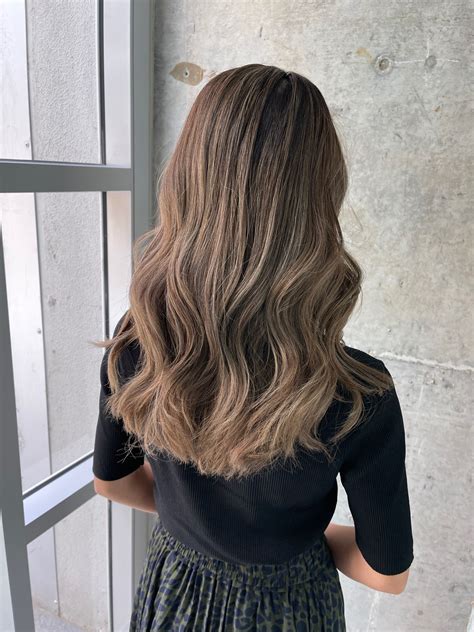Introduction
Balayage, a French hair coloring technique, has gained immense popularity among Asian women seeking to add depth, dimension, and radiance to their dark locks. Balayage involves hand-painting hair with lightener to create natural-looking, sun-kissed highlights. This technique allows for limitless customization, enabling Asian women to embrace their unique hair textures and tones.

Benefits of Balayage for Asian Hair
- Natural-Looking Highlights: Balayage creates subtle, blended highlights, mimicking the sun’s natural lightening effects.
- Adds Dimension and Volume: The contrast between the darker base and lighter highlights adds depth and volume, enhancing the hair’s texture.
- Low Maintenance: Compared to traditional highlighting techniques, balayage requires less frequent touch-ups, saving time and money.
- Versatile Styling Options: Balayage allows for versatility in styling, from sleek and chic to voluminous and beachy waves.
- Corrects Color Damage: Balayage can help correct previous color damage by blending highlights with the natural base color, creating a more uniform and healthy appearance.
Balayage Techniques for Asian Hair
Types of Balayage
- Traditional Balayage: involves painting on lightener freehand using a brush, creating soft, diffused highlights throughout the hair.
- Foilyage: combines balayage with foils, enhancing the lightening process by trapping heat and allowing for more precise placement of highlights.
- Reverse Balayage: starts with lightened tips and gradually blends into a darker base, creating an ombré or dip-dyed effect.
Choosing the Right Shade
The ideal balayage shade for Asian hair depends on the natural hair color and desired result.
- For Dark Brown Hair: Warm caramel, honey, or golden blonde shades add warmth and dimension.
- For Medium Brown Hair: Ashy or beige tones create a soft, understated highlight.
- For Black Hair: Copper or auburn highlights can add vibrant pops of color while maintaining the hair’s depth.
Creating a Customized Look
Balayage allows for endless customization options. Consider factors such as:
- Hair Texture: Fine hair requires more subtle highlights, while thick hair can handle bolder contrasts.
- Face Shape: Highlights can be strategically placed to accentuate or soften facial features.
- Personal Style: Achieve a glamorous, edgy, or natural look depending on the desired level of contrast and brightness.
The Process of Balayage on Asian Hair
- Consultation: Discuss hair history, desired results, and appropriate techniques with a skilled colorist.
- Sectioning: The hair is divided into sections to facilitate the application of lightener.
- Application: Lightener is hand-painted onto the hair using a brush or foiling technique.
- Processing: The lightener is allowed to process for a predetermined time, monitored by the colorist.
- Toning: A toner is applied to neutralize brassy tones and enhance the desired shade.
- Finishing: The hair is shampooed, conditioned, and styled to complete the transformation.
Caring for Balayage Asian Hair
- Use Color-Protecting Shampoo and Conditioner: Choose products specifically designed for color-treated hair to maintain vibrancy.
- Limit Heat Styling: Heat can damage balayage highlights, so use styling tools on low settings or apply a heat protectant spray.
- Regular Trims: Trim split ends to keep hair healthy and prevent breakage.
- Protect from Sun Exposure: UV rays can lighten highlights and damage hair, so wear a hat or use a UV protectant spray when outdoors.
Tips and Tricks for Asian Hair Balayage
- Start Subtle: Begin with subtle highlights and gradually increase the contrast as desired.
- Blend the Base: Avoid harsh lines by seamlessly blending the base color with the highlights.
- Use a Gloss Treatment: A gloss treatment can add shine and enhance the depth of balayage highlights.
- Embrace Your Natural Texture: Balayage complements all hair textures, from straight to curly.
- Consider the Lifestyle: Choose a balayage style that aligns with your lifestyle and maintenance routine.
Frequently Asked Questions (FAQs)
- Is balayage suitable for all Asian hair types? Yes, balayage can be customized to suit all Asian hair textures and tones.
- How often should I get balayage touch-ups? Touch-ups are typically recommended every 4-8 weeks, depending on hair growth and desired level of contrast.
- Can balayage damage my hair? If performed by a skilled colorist, balayage can be a low-damage hair coloring technique.
- Can I DIY balayage at home? Not recommended. Balayage requires professional skills and techniques to achieve optimal results.
- What are the different levels of contrast in balayage? Balayage contrast ranges from subtle to high-impact, with options like babylights, face-framing, and ombre balayage.
- Is balayage more expensive than traditional highlighting? Balayage can be slightly more expensive due to the time and skill required.
- Can balayage be done on previously colored hair? Yes, balayage can be used to refresh or enhance existing hair color.
- Is balayage suitable for short hair? Yes, balayage can add dimension and texture to short hair styles.
Conclusion
Balayage Asian hair is a transformative hair coloring technique that empowers Asian women to express their unique beauty and style. By embracing the versatility and natural-looking highlights of balayage, Asian women can enhance the depth, shine, and style of their hair. With proper care and customization, balayage can be a low-maintenance, flattering addition to any hair journey.
